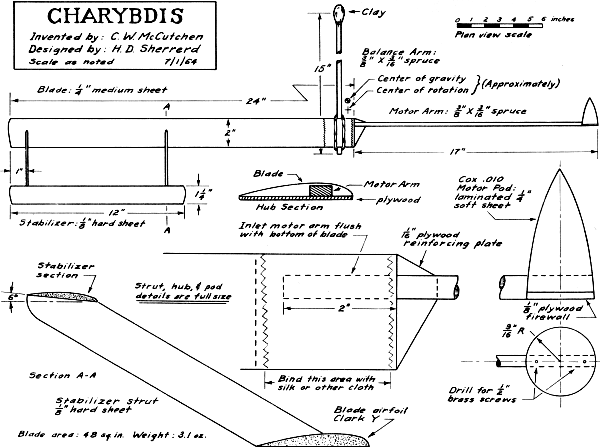Charybdis
#1

Thread Starter
My Feedback: (1)
Join Date: May 2003
Location: Orangeville, ON, CANADA
Posts: 8,658
Likes: 0
Received 2 Likes
on
2 Posts
.010 fans - found this just now on the net. Get building! I made one in the early '70's exactly like this, and several .049 versions in later years, and have one still going. Oddly I started making another .010 version about a month ago, idly in the workshop. Ready for finishing now, but this one is high tech - CF engine and counterweight boom, streamlined engine pod and enclosed pressure bladder. .010's run fine on them and takes care of the g forces screwing up the mixture. Like the author describes, I had a memorable thermal flight on the 1/2a few years ago, slowly climbing to 200-300', slowly descending, repeated this a few times for a flight of several minutes. Dead calm summer day, lunchtime, dirt field over the fence, lots of sun.. and lots of bubbles. I've never had a trim tab on one, must experiment sometime. Hand launching is easy, I hold the hub with m right hand, the engine pod with my left, tossing the motor forward while spinning it and pushing up with the other. It doesn't need a Herculean twist or toss, the wing loading is modest.
[h=2]Charybdis[/h] With a twist of your wrist, this single-bladed, .010-powered thing swishes aloft. Great fun and easy to make.By H.D.M. Sherrerd, Jr.
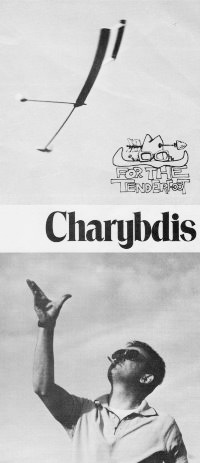 In Greek mythology, Charybdis was an extremely powerful whirlpool off the Sicilian coast. This helicopter is not particularly powerful, but like its namesake, everything revolves at a rather high rate of speed, and to that degree at least the name was appropriately chosen by the inventor, Charles W. McCutchen of Princeton, New Jersey.
In Greek mythology, Charybdis was an extremely powerful whirlpool off the Sicilian coast. This helicopter is not particularly powerful, but like its namesake, everything revolves at a rather high rate of speed, and to that degree at least the name was appropriately chosen by the inventor, Charles W. McCutchen of Princeton, New Jersey.
Charybdis was developed 18 years ago, while McCutchen was living in Cambridge, England, and caused something of a sensation when he took it to the British Nationals of 1954. Since that time, variations on the "McCutchen Machine," as the design is more generally called, have occasionally appeared in European magazines, but a prophet is usually without honor in his own country, and the Charybdis seems to have been completely ignored in the U.S.-a pity, since it is no tougher to build than a good hand-launched glider, and more fun than tying firecrackers to your old flying scales.
Construction
Construction is quite simple, with the emphasis on strength. The blade and stabilizer are of sheet rather than built-up, the motor and balance arms are of spruce, and the hub is reinforced with 1/16th plywood. The motor arm is inlaid into the lower surface of the blade, the reinforcing plate double-glued over the joint, and the whole bound with silk or other light cloth. This area is then virtually unbreakable, and also a good flat surface for the balance arm to bear against. You can, of course, glue or even bolt the balance arm in place, but Charybdis is much easier to carry around if the arm is detachable.
The blade is simply a 2' x 2" lath of 1/4-in. medium sheet balsa, shaped to a constant Clark Y section. No wash-in, no wash-out, no dihedral breaks; the squarest, easiest wing you ever made. Use a template to maintain section accuracy. Don't try something with undercamber instead. McCutchen tried both undercambered and curved-sheet airfoils, and found the resulting Charybdis to be unimproved, at best, or just plain unstable, at worst.
The stabilizer struts are 1/8th hard sheet sanded to a streamline section. Use plenty of glue and perhaps even some silk reinforcing at the strut-to-stabilizer joint, the only vulnerable area of Charybdis. The stabilizer itself is also 1/8th hard sheet, but is given a lifting section. Be careful to set it at an angle of at least -50 or -60 relative to the blade, as this is most important.
The motor pod is so designed mainly because it looks good. The streamlining probably helps a bit, but is really unnecessary. On the other hand, it does provide a solid mass behind the firewall (if you can call it that) and a little more weight. (The Cox 010 is awfully light.) The 1/8-in. plywood firewall is inlaid into the motor arm, and the pod itself built up from the same 1/4-in. stock used for the blade, or anything else in the scrap box, then carved and sanded to shape With the motor inverted, as shown in the photos, the mounting screws bear through into the spruce arm instead of the soft balsa. Add a wire guard loop if you think it necessary, but the prop generally seems to be enough protection for the glow plug even when landing on bare spots.
[TABLE="width: 310"]
[TR]
[TD]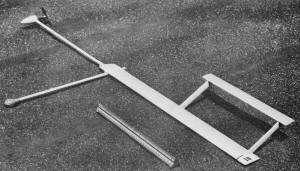
This has got to be the easiest helicopter type thing yet-only one rotor blade!
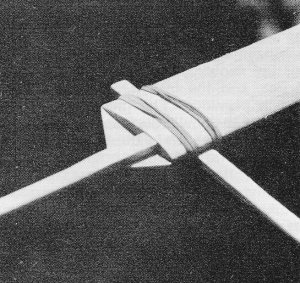
Rubber band mounted weight boom affords easy adjustment of CG and crash protection.
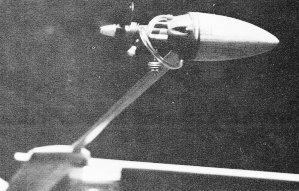
Inverted Cox .010 works much better than if it were upright, but no one knows why. Don't fly over concrete.
[/TD]
[/TR]
[/TABLE]
Thinned, clear, hot, fuel proof dope is used on everything except the motor pod and adjacent portion of the motor arm, where straight dope is used for extra protection. Colored dope could be used, of course, and should produce a pretty jazzy effect with Charybdis revolving at the speed it does.
The inverted position of the Cox 010 has been found the best after much painful trial and error. The tank outlet is slightly high, but the fuel line itself is at the extreme outside of the swept circle, and fuel does not have to fight centrifugal force on its way to the needle valve. The other arrangements that seem so obvious either don't work for one reason or another, or offer no particular advantage.
Because of variations in engines, fuels, weather, altitude, etc., finding the proper needle valve setting is something you must do yourself; there is nothing else for it. But there is one peculiarity of the system worth mentioning that makes all the difference in running time: an odd combination of forces and pressures is at work that requires blocking off one of the filler nipples for maximum engine duration. With both nipples open, engine run will be 15 to 20 seconds. With one blocked off, the run will be well over a minute. This can be done with a short length of pinched-off tubing, or a longer piece running to the pressure-tap nipple. With this latter system you don't lose the short piece in the grass while fueling-it stays attached to the pressure-tap. You can, of course, use a control-line tank and find the optimum setup yourself. However, the shortest fuel line is always the best, and use of the integral tank has the advantages of simplicity, strength, and aerodynamic cleanliness.
Flying
Launching may seem a bit hairy at first, but is really no problem if the CG is located approximately as shown. To avoid losing fuel from the inverted tank, turn the Charybdis upside-down and start as usual. Now grasp the hub area with your fingertips on the blade leading edge and thumb on trailing. Raise the whole affair over your head while simultaneously turning it upright; snap your wrist to start rotation, and push upwards. Then duck, and run into the wind, since you probably haven't got the carburetion right to begin with. Try again, until the engine continues to run and Charybdis climbs away like a startled mallard.
An alternate launch method is to gusset the general area of the CG, drill a small hole at the approximate center of rotation, and impale the Charybdis on a headless nail driven into the end of a stick. In this case Charybdis will simply fly itself off once it picks up sufficient speed. McCutchen remarks that this is a good idea while getting the carburetion and balance unscrambled, since it prevents powered crashes while in an unstable condition.
Once properly trimmed, Charybdis is remarkably stable. The rate of climb can be varied by adding or removing clay, and by sliding the balance arm in and out. But this will not make as much difference as you might think, and unless carried to extremes, will not seriously disturb autorotation characteristics following engine shut-down. If the Charybdis is really out of balance, of course it won't take off to begin with. Changing the stabilizer angle, on the other hand, will make a great difference in rate of climb. An adjustable stabilizer, or at least a movable tab on the' fixed one, would permit complete freedom of experimentation.
The other factor that most strongly affects performance is power. With the 3 x 1.25 standard .010 prop, time from launch to touchdown averages around a minute and 30 to 45 seconds. Charybdis climbs steadily for several hundred feet, depending on engine run, then descends in autorotation for anything from 30 seconds to a minute. On one memorable flight of this sort, the Charybdis got hung up in a thermal at 100 feet or so and just sat there, silently autorotating
over one spot for something close to two minutes. Total time was 3:15 for a rather different max flight.
But to really have a ball with Charybdis, try this: Turn the prop around to reduce thrust, or use a 4-1/2 x 2, .020 prop, pile more clay on the balance arm, maybe try a masking tape trim tab on the elevator-anything to hold it down. It will take a while to work out, but you can get the Charybdis to hover waist-high. It will first sink to a grass-cutting level, then find an equilibrium altitude in ground effect at two or three feet, and just sit there, drifting with the breeze, following the contour of the ground. McCutchen rigged one to do this so well that it would go down the gentle bank of a stream, cross over, then climb the opposite bank and continue wandering off across the fields. He says it was quite upsetting to casual observers along the flight path.
While hovering like this, Charybdis will produce the weirdest sound you have ever heard outside a science-fiction movie. You'll think the Martians are coming-it is a kind of whoop-whoop-whoop-whoop gradually increasing in pitch and frequency, with an underlying humming note, and the scream of the engine. All this may be only a peculiarity of the author's Charybdis, and may not be true for others-even working from the same plans, everyone builds slightly differently. But for the Charybdis in the photos it's real. And strange.
AAR Note: The Charybdis' principle of flight is very similar to that of the familiar maple tree seed. Here is NASA's page on them.
[h=2]Charybdis[/h] With a twist of your wrist, this single-bladed, .010-powered thing swishes aloft. Great fun and easy to make.By H.D.M. Sherrerd, Jr.
 In Greek mythology, Charybdis was an extremely powerful whirlpool off the Sicilian coast. This helicopter is not particularly powerful, but like its namesake, everything revolves at a rather high rate of speed, and to that degree at least the name was appropriately chosen by the inventor, Charles W. McCutchen of Princeton, New Jersey.
In Greek mythology, Charybdis was an extremely powerful whirlpool off the Sicilian coast. This helicopter is not particularly powerful, but like its namesake, everything revolves at a rather high rate of speed, and to that degree at least the name was appropriately chosen by the inventor, Charles W. McCutchen of Princeton, New Jersey.Charybdis was developed 18 years ago, while McCutchen was living in Cambridge, England, and caused something of a sensation when he took it to the British Nationals of 1954. Since that time, variations on the "McCutchen Machine," as the design is more generally called, have occasionally appeared in European magazines, but a prophet is usually without honor in his own country, and the Charybdis seems to have been completely ignored in the U.S.-a pity, since it is no tougher to build than a good hand-launched glider, and more fun than tying firecrackers to your old flying scales.
Construction
Construction is quite simple, with the emphasis on strength. The blade and stabilizer are of sheet rather than built-up, the motor and balance arms are of spruce, and the hub is reinforced with 1/16th plywood. The motor arm is inlaid into the lower surface of the blade, the reinforcing plate double-glued over the joint, and the whole bound with silk or other light cloth. This area is then virtually unbreakable, and also a good flat surface for the balance arm to bear against. You can, of course, glue or even bolt the balance arm in place, but Charybdis is much easier to carry around if the arm is detachable.
The blade is simply a 2' x 2" lath of 1/4-in. medium sheet balsa, shaped to a constant Clark Y section. No wash-in, no wash-out, no dihedral breaks; the squarest, easiest wing you ever made. Use a template to maintain section accuracy. Don't try something with undercamber instead. McCutchen tried both undercambered and curved-sheet airfoils, and found the resulting Charybdis to be unimproved, at best, or just plain unstable, at worst.
The stabilizer struts are 1/8th hard sheet sanded to a streamline section. Use plenty of glue and perhaps even some silk reinforcing at the strut-to-stabilizer joint, the only vulnerable area of Charybdis. The stabilizer itself is also 1/8th hard sheet, but is given a lifting section. Be careful to set it at an angle of at least -50 or -60 relative to the blade, as this is most important.
The motor pod is so designed mainly because it looks good. The streamlining probably helps a bit, but is really unnecessary. On the other hand, it does provide a solid mass behind the firewall (if you can call it that) and a little more weight. (The Cox 010 is awfully light.) The 1/8-in. plywood firewall is inlaid into the motor arm, and the pod itself built up from the same 1/4-in. stock used for the blade, or anything else in the scrap box, then carved and sanded to shape With the motor inverted, as shown in the photos, the mounting screws bear through into the spruce arm instead of the soft balsa. Add a wire guard loop if you think it necessary, but the prop generally seems to be enough protection for the glow plug even when landing on bare spots.
[TABLE="width: 310"]
[TR]
[TD]

This has got to be the easiest helicopter type thing yet-only one rotor blade!

Rubber band mounted weight boom affords easy adjustment of CG and crash protection.

Inverted Cox .010 works much better than if it were upright, but no one knows why. Don't fly over concrete.
[/TD]
[/TR]
[/TABLE]
Thinned, clear, hot, fuel proof dope is used on everything except the motor pod and adjacent portion of the motor arm, where straight dope is used for extra protection. Colored dope could be used, of course, and should produce a pretty jazzy effect with Charybdis revolving at the speed it does.
The inverted position of the Cox 010 has been found the best after much painful trial and error. The tank outlet is slightly high, but the fuel line itself is at the extreme outside of the swept circle, and fuel does not have to fight centrifugal force on its way to the needle valve. The other arrangements that seem so obvious either don't work for one reason or another, or offer no particular advantage.
Because of variations in engines, fuels, weather, altitude, etc., finding the proper needle valve setting is something you must do yourself; there is nothing else for it. But there is one peculiarity of the system worth mentioning that makes all the difference in running time: an odd combination of forces and pressures is at work that requires blocking off one of the filler nipples for maximum engine duration. With both nipples open, engine run will be 15 to 20 seconds. With one blocked off, the run will be well over a minute. This can be done with a short length of pinched-off tubing, or a longer piece running to the pressure-tap nipple. With this latter system you don't lose the short piece in the grass while fueling-it stays attached to the pressure-tap. You can, of course, use a control-line tank and find the optimum setup yourself. However, the shortest fuel line is always the best, and use of the integral tank has the advantages of simplicity, strength, and aerodynamic cleanliness.
Flying
Launching may seem a bit hairy at first, but is really no problem if the CG is located approximately as shown. To avoid losing fuel from the inverted tank, turn the Charybdis upside-down and start as usual. Now grasp the hub area with your fingertips on the blade leading edge and thumb on trailing. Raise the whole affair over your head while simultaneously turning it upright; snap your wrist to start rotation, and push upwards. Then duck, and run into the wind, since you probably haven't got the carburetion right to begin with. Try again, until the engine continues to run and Charybdis climbs away like a startled mallard.
An alternate launch method is to gusset the general area of the CG, drill a small hole at the approximate center of rotation, and impale the Charybdis on a headless nail driven into the end of a stick. In this case Charybdis will simply fly itself off once it picks up sufficient speed. McCutchen remarks that this is a good idea while getting the carburetion and balance unscrambled, since it prevents powered crashes while in an unstable condition.
Once properly trimmed, Charybdis is remarkably stable. The rate of climb can be varied by adding or removing clay, and by sliding the balance arm in and out. But this will not make as much difference as you might think, and unless carried to extremes, will not seriously disturb autorotation characteristics following engine shut-down. If the Charybdis is really out of balance, of course it won't take off to begin with. Changing the stabilizer angle, on the other hand, will make a great difference in rate of climb. An adjustable stabilizer, or at least a movable tab on the' fixed one, would permit complete freedom of experimentation.
The other factor that most strongly affects performance is power. With the 3 x 1.25 standard .010 prop, time from launch to touchdown averages around a minute and 30 to 45 seconds. Charybdis climbs steadily for several hundred feet, depending on engine run, then descends in autorotation for anything from 30 seconds to a minute. On one memorable flight of this sort, the Charybdis got hung up in a thermal at 100 feet or so and just sat there, silently autorotating
over one spot for something close to two minutes. Total time was 3:15 for a rather different max flight.
But to really have a ball with Charybdis, try this: Turn the prop around to reduce thrust, or use a 4-1/2 x 2, .020 prop, pile more clay on the balance arm, maybe try a masking tape trim tab on the elevator-anything to hold it down. It will take a while to work out, but you can get the Charybdis to hover waist-high. It will first sink to a grass-cutting level, then find an equilibrium altitude in ground effect at two or three feet, and just sit there, drifting with the breeze, following the contour of the ground. McCutchen rigged one to do this so well that it would go down the gentle bank of a stream, cross over, then climb the opposite bank and continue wandering off across the fields. He says it was quite upsetting to casual observers along the flight path.
While hovering like this, Charybdis will produce the weirdest sound you have ever heard outside a science-fiction movie. You'll think the Martians are coming-it is a kind of whoop-whoop-whoop-whoop gradually increasing in pitch and frequency, with an underlying humming note, and the scream of the engine. All this may be only a peculiarity of the author's Charybdis, and may not be true for others-even working from the same plans, everyone builds slightly differently. But for the Charybdis in the photos it's real. And strange.
AAR Note: The Charybdis' principle of flight is very similar to that of the familiar maple tree seed. Here is NASA's page on them.
#2
Senior Member
My Feedback: (3)
This is one of the most ingenious devices ever built that most likely never earned anyone a single dime.
The inventor must have been pretty thrilled to see his idea take off and drill it's way upward..!
We have some trees around here that deposit miniature Charybdis-like seed pods by the millions.
The inventor must have been pretty thrilled to see his idea take off and drill it's way upward..!
We have some trees around here that deposit miniature Charybdis-like seed pods by the millions.
#5

Thread Starter
My Feedback: (1)
Join Date: May 2003
Location: Orangeville, ON, CANADA
Posts: 8,658
Likes: 0
Received 2 Likes
on
2 Posts
Got yours built yet? Go 4 x 30-32" for an .049, stick with the stab negative incidence recommended - 5-6 degrees. That's the magic.. torque the wing into positive angle of attack on climb, autorotate on descent.
#7

Thread Starter
My Feedback: (1)
Join Date: May 2003
Location: Orangeville, ON, CANADA
Posts: 8,658
Likes: 0
Received 2 Likes
on
2 Posts
They are bizarre, but actually quite user friendly - get it about right and off they go. The Russians held the helicopter duration record for ages with one - in the '50's, 60's Russians and Brits and who else would build these things with built up wings and small diesel engines with central tanks.. and fly forever. Too much fun not to build one. It's a 1-1/2 - 2 hour build plus finishing touches. Run a Sure Start on pressure, solves the centrifugal fuel delivery nightmares. Depending what engine/tank arrangement you use, I've had examples where the engine had to be almost choking on fuel before I could let it go. Others needed only a minor offset. Helps when you take a couple of minutes to plan ahead on the fuel system..
Needs an LED strip and small LiPO at the hub.
Needs an LED strip and small LiPO at the hub.
#10

Thread Starter
My Feedback: (1)
Join Date: May 2003
Location: Orangeville, ON, CANADA
Posts: 8,658
Likes: 0
Received 2 Likes
on
2 Posts
Argggh.. wanna go... the airfare is $600 plus accommodations and all that. Only so many field trips a guy can do. I was planning to go to Days of Speed and Thunder this year..
#11

Join Date: Jul 2005
Location: Upper HuttWellington, NEW ZEALAND
Posts: 1,601
Likes: 0
Received 1 Like
on
1 Post
Actually technically they're 'McCutchen flying machines' after Charles McCutchen the American postdoctoral nuclear physicsstudent at Cambridge University who first created them in 1953-ostensibly as the result of a bet in a pub to design the simplest stable powered flying machine. The 'Charybdis' was a nod to one of the two legendary monsters believed to live in the Straits of Messina between Siciliy and the mainland; Charybdis was a whirlpool that could swallow ships whole....
Attached are scans of the original article published in Aeromodeller the July 1954 issue
ChrisM
'ffkiwi'
#12
Looks like you could do a manned quad with single blades to make max thrust for min HP.
Who will be the first to fly on less than 5 HP???
The World Prize Committee is currently offering $10,000 peso's to the first one that can fly a 6 mile course without recharging or refueling.
Who will be the first to fly on less than 5 HP???
The World Prize Committee is currently offering $10,000 peso's to the first one that can fly a 6 mile course without recharging or refueling.

#13

Join Date: Jul 2005
Location: Upper HuttWellington, NEW ZEALAND
Posts: 1,601
Likes: 0
Received 1 Like
on
1 Post
They are bizarre, but actually quite user friendly - get it about right and off they go. The Russians held the helicopter duration record for ages with one - in the '50's, 60's Russians and Brits and who else would build these things with built up wings and small diesel engines with central tanks.. and fly forever. Too much fun not to build one. It's a 1-1/2 - 2 hour build plus finishing touches. Run a Sure Start on pressure, solves the centrifugal fuel delivery nightmares. Depending what engine/tank arrangement you use, I've had examples where the engine had to be almost choking on fuel before I could let it go. Others needed only a minor offset. Helps when you take a couple of minutes to plan ahead on the fuel system..
Needs an LED strip and small LiPO at the hub.
Needs an LED strip and small LiPO at the hub.
A thought just strikes me-I don't think ANYONE has done an electric one yet......just think-a small brushless, a small Lipo-plus a motor run timer.......no more fuel feed issues.....who's going to be first? The pic shows the unsuccessful 049 McCutchen which I'll revisit one day...
ChrisM
'ffkiwi'
#19
Senior Member
Join Date: Jan 2003
Location: BARNWELL,
SC
Posts: 990
Likes: 0
Received 0 Likes
on
0 Posts
Post #124 on this page shows my .010 and Dan Berry's .020 being launched and in the air. Flown at the SMALL fly-in in Little Rock. First weekend of June starting on Thursday. I plan to be there again with mine.
http://www.rcgroups.com/forums/showt...1372947&page=9
http://www.rcgroups.com/forums/showt...1372947&page=9




